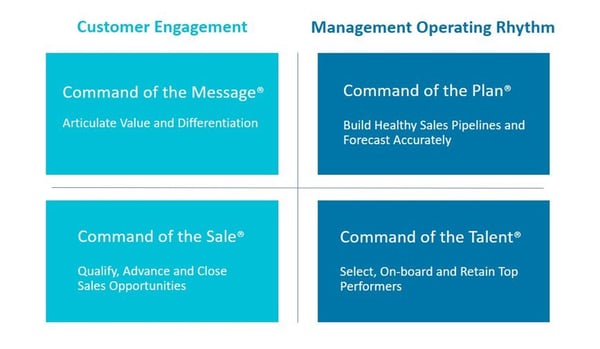
How Do You Hire Elite Salespeople?
Categories: Talent Management | Sales Qualification
Very often in our engagements, our customers ask us to comment on their people. They ask questions like, “What do you think of our people?” and “Do you think we have the right people?” These are very common questions.
Before I answer these questions about anybody’s people, I like to dig in a little further. I always ask them to tell me, “How do you define success in this or that role?”. It's amazing how many people struggle to give me a measurable answer to this question. A lot of people tell me things like, “They have to be smart”; “They have to have grit”; and my all-time favorite, “They have to have it".
The most elite sales leaders in the world all have these two things in common, “Command of their Plan” and “Command of their Talent”. Talent is integral to all quadrants of Sales Effectiveness:

Once you get your message squared away, you see that it may begin to call for some different competencies and behaviors. Once you get your sales process and engagement model created, you begin to see that those critical activities required tend to map to certain competencies and behaviors. And, once you put together your sales planning process, companies like to find people who have those type of experiences and competencies with their ideal customer profile.
No matter how you slice it or dice it, your talent strategy is critical to everything you do in a company. Take the time to create a success profile by mapping it against what success looks like in YOUR company, not somebody else’s. Source for it, interview and hire to it. Develop and performance manage to it and assess your organization against it for succession planning.
Finding The Right Type of Sales Experience
Now there is a lot of talk lately about experience especially with our high tech customers. They are struggling to find the right balance between industry experience and an elite seller. Often, this topic merges into a conversation about hunters and farmers. How do you make a decision between hunters and farmers? When this topic is focused around critical activities in a sales and engagement process, it can be a complicated subject. We have tons of ideas around this that will be a separate topic for a blog in the near future. In this blog, what I would like to discuss is something more fundamental, but just as critical.
I remember working with a great technology company in the user-generated content marketing space. The CEO pulled me in his office and lamented about his people. He said, “A lot of our people just do not have the right experience that is needed to sell our products.”
I listened and asked him, “How do you know that your people do not have the right experience? Exactly what experience do you need?”
He gave me very general answers around understanding marketing, marketers, advertisers and brands. These answers all made pretty good sense to me, but then I asked him a question that took us down a very interesting path. I asked him to determine who his number one seller was. Surprisingly to him, the top seller did not come from the marketing or advertising space and had only been selling for one year.
You should have seen the look on the CEO’s face, as I let him just sit with his own thoughts on these facts. He then asked me, “How do I know that this is not just an anomaly or a 'unicorn' seller?" We dug deeper. This seller had come from another industry, but had great enterprise SaaS experience with a company that had:
- a great message
- a clearly defined sales process and engagement model
- a culture of accountability
- access to the right resources at the right time
In fact, these were the very same attributes that were making this seller successful in this current company. The CEO began to tell me why industry experience was so critical in the sales role. He was making good sense when speaking about credibility, insights and leverage.
I dug deeper with him by asking, “What specific experience do you need in the role?”
He said that it was important to really have “lived” some of the pains of the buyers and to have a good understanding of the relationships and decision making with customers.
I listened and then asked the CEO, “Can’t you teach a seller these things?”
Before he could answer, I said, “Before you answer, remember your number one seller had none of what you are describing prior to coming to your company.”
The CEO looked at me intently and said, “Well I don’t know if you can teach someone those things. What do you think?”
Before I answered, I shared an analogy with him.
Hunters and Zoologists
For the purposes of this story, let’s say we are trying to hunt a bear. A Zoologist is someone who studies the behavior, origins, genetics, diseases and life progression of animals and wildlife. The Zoologist can tell me how the bear lives, how the bear eats and when the bear sleeps. There is only one problem. The Zoologist can’t shoot the bear to save his/her own life. And in this story, the Hunter has little understanding of how the bear lives, how the bear eats and when the bear sleeps.
The CEO smiled at me and nodded. I said, “I am telling you this story because it is relevant to your situation. We started this conversation talking about your sellers. Basically, you told me that you needed more Zoologists to hunt your bear, correct?”
“Yeah kind of," he said.
“We established that the Zoologist is valuable to the hunt, however he is probably not the best at shooting the bear and bringing it down, agreed?”
The CEO nodded in agreement.
“Let’s go back to your real scenario in your company," I said. “Your number one seller is a born and bred hunter, who has learned the ways of the bear from Zoologists in your company. This proves to me that you can teach the hunters everything they need to know about the bear, and they will use their specific hunting skills to bring it down.”
He thought he needed a zoologist, but what he really needed was a hunter.
Aligning on the Essential Questions
It was time for me to do my own hunting. I transitioned into our Command of the Message Methodology which creates a framework around four essential questions:
- What problems do you solve for your customers?
- How specifically do you solve them?
- How do you solve them differently or better than your competition?
- Where have you done this before? (proof points)
These questions were important to the CEO, because they're the ultimate instructions for the Hunter. Once you arm Hunters with these answers, you can turn them in the field and let them do what they do best - SHOOT BEARS.
The CEO loved the analogy, but asked me, “What about all the Zoologists?”
That was a very good question! I told him that the next thing he needed to consider was the operating rhythm and cadence of the hunt. The most elite companies in the world create an operating rhythm between the function of Hunting and Zoology. Notice I made an important distinction between the function and the person. You don't want to design a Customer Engagement Model (the Hunt) around people, but around the functions of the role. The people you need will begin to be obvious based upon the function required.
Mapping the Functions
Once you have developed a methodology to answer the Four Essential Questions of Value, you then have to develop a Client Engagement Model that captures all that value. We call this having command of your sales process and customer engagement model. You must begin with mapping your customer's buying processes.
Most companies don’t start building their customer engagement processes from a buyer perspective. They take an inside-out approach instead of an outside-in approach. This focus on ourselves before the buyer is how we get misaligned with our customers. We try to get them to do "our selling activities” versus aligning to "their buying activities”.
Once we have aligned our selling process to the customer's buying process by determining the actual stages we need to go through to move an opportunity forward, we can now describe the critical actions that need to take place. This identification makes it a lot easier to see who should be doing that activity.
So now we have a wonderfully choreographed process that defines accountability, outlining who does what when. The final step is to establish the specific qualification criteria that allows the sellers to progress and helps them voraciously qualify the opportunities, drastically increasing the accuracy of the forecast. One example is the MEDDICC qualification process we used at PTC. This process vaulted the company to 43 straight quarters of double digit profitable revenue growth. That is over ten years of never missing a forecasted number to Wall Street!
Back to the Hunters
The last thing I said to the CEO was, “Here is what we have found. The most elite Hunters in the world will not come to your company unless you have these things in place. So if you don’t commit to getting them in place, this whole conversation is useless.”
You should have seen the CEO’s eyes light up when I finished my story.
He slammed his hand down on the desk and said, “That is exactly what I need, when can we get started?!”
I have the greatest job in the world. I wish you good selling.
#beuncommon; #whosdoingthis



